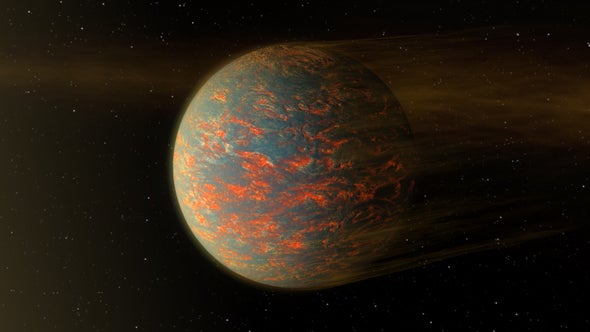(单词翻译:单击)
听力文本
This is Scientific American's 60-second Science, I'm Christopher Intagliata.
Here on Earth, your best bet for seeing lava is to go to a volcano. But out in space, there are entire exoplanets made of the stuff. These so-called lava worlds orbit so close to their stars that their surface temperatures can melt rock—which might sound familiar, says space technologist Mihkel Pajusalu of the University of Tartu in Estonia.
"For example, from science fiction, we know, from Stars Wars: Episode III, Mustafar planet..."
(CLIP: Star Wars scene)
Kinda like that but, you know, without the light sabers. Scientists had noticed that some of these real lava worlds were extraordinarily bright and reflective. But why?
"There was the idea that maybe it comes from the fact lava itself is basically a liquid, and a smooth surface can reflect light. Like the surface of water, for example."
So Pajusalu and his colleagues did what anyone would do to test that idea: they made their own lava. Here's M.I.T.'s Zahra Essack, who led the team.

"When we removed the lava from the furnace, you could instantly feel the heat wash over you. Even from six feet away, it felt like you were standing right on the edge of a roaring bonfire. The crucible, which was the container holding the lava, was glowing so brightly, it made my eyes water. It was an incredible experience."
After producing the lava, the researchers calculated its reflectivity in both the molten and solid states. And they realized that lava wasn't reflective enough to explain these bright exoplanets they were seeing. Instead, Essack says, perhaps these planets could be remarkable in yet another way.
"We think that lava planets could have exotic reflective atmospheres consisting of silica, which is the main component of rocks, and metals like sodium and potassium that could reflect starlight and make the planets appear very bright."
The work appears in the Astrophysical Journal.
If lava worlds feel very far away, and perhaps irrelevant, Essack brought up the fact that Earth was once covered in sloshing lava early in its formation. So by studying planets around distant stars, we might better understand the history of our own.
Thanks for listening for Scientific American's 60-second Science. I'm Christopher Intagliata.
参考译文
这里是科学美国人——60秒科学系列,我是克里斯托弗·因塔格里塔。
在地球上,如果你想看到熔岩,那最好的方法就是去火山。但在太空中,存在整个由这种物质构成的系外行星。这些所谓的“熔岩世界”的轨道与其恒星极为接近,以致于其表面温度可熔化岩石,爱沙尼亚塔尔图大学的太空技术专家米克尔·帕朱萨鲁表示,这听起来可能很熟悉。
“比如,科幻小说和《星球大战》系列第三集中提到的穆斯塔法星……”
(音频片段:星球大战场景)
和那种类似 ,但是,没有光剑。科学家注意到,这些真实的熔岩世界中有些非常明亮并具反光性。但原因为何?
“有人认为这可能是因为熔岩本身基本上是液体,光滑的表面可以反射光线。就像水面一样。”
因此,帕朱萨鲁及同事做了任何人都会做的事情,来验证这个想法:他们自己制造了熔岩。以下是领导该团队的麻省理工学院的扎赫拉·埃萨克所说。
“当我们从熔炉中取出熔岩时,立刻就感觉到热浪席卷而来。即使在六英尺以外的地方,你也会有自已就站在熊熊燃烧的篝火边的感觉。坩埚是盛装熔岩的容器,它发出的光非常明亮,以致于会让我的眼睛湿润。这是一次难以置信的经历。”
制造出熔岩之后,研究人员计算了熔岩在熔融状态和固态下的反射率。他们发现,熔岩的反射性不足以解释他们所看到的这些明亮的系外行星。埃萨克表示,也许这些行星以另一种方式引人注目。
“我们认为熔岩行星可能有奇特的反射性大气层,由二氧化硅(岩石的主要成分)和钠、钾等金属组成,这些金属可以反射星光,使行星显得非常明亮。”
这项研究发表在《天体物理学杂志》上。
如果你感觉熔岩世界很遥远,可能并不相关,埃萨克提出了这样一个事实:地球在形成早期曾经被晃动的熔岩所覆盖。因此,通过研究遥远恒星周围的行星,我们也许可以更好地了解我们自己的历史。
谢谢大家收听科学美国人——60秒科学。我是克里斯托弗·因塔利亚塔。
译文为可可英语翻译,未经授权请勿转载!
重点讲解
重点讲解:
1. be made of (由…)构成的;(由…)制成的;
The top of the table is made of glass.
桌面由玻璃制成。
2. come from 来自;始于;
They come from totally different cultures.
他们来自完全不同的文化。
3. consist of 由…组成;由…构成;
The performance consisted of dance, music and mime.
演出包括舞蹈、音乐和哑剧。
4. bring up 提出;
Instead of staying in the here and now, you bring up similar instances from the past.
你没有紧扣眼前所发生的事,而是只提出了一些过去的类似事例。
关注微信公众号【可可双语精读】,获取详细讲解内容


